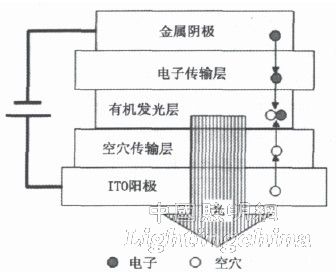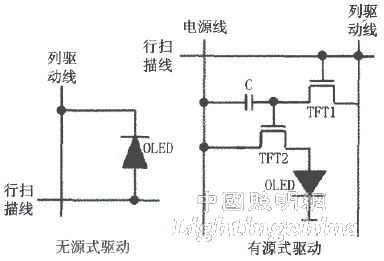0 Preface
The 21st century is the era of "3C", that is, communication, computer and consumer electronics. In such an era, people are increasingly demanding flat-panel displays. Flat panel displays, from tens of inches of billboards to mobile displays up to one inch in size, including STN-LCD (Super Twisted Nematic Liquid Crystal), TFT-LCD (Thin Film Transistor Liquid Crystal Display), and PDP (Plasma Flat Panel Display) ) and other displays. OLED (Organic Electroluminescent Display) is the latest development, but it has become the most promising and most likely to replace LCD displays. Compared with LCD, OLED has many advantages: low driving voltage (below 10V); self-illumination, no need for backlight, greatly reduced power consumption; wide viewing angle, above 170°; fast response time, about 10~100ns; no LCD The phenomenon of afterimage can be produced in full color, including RGB three primary colors and white light; brightness can be as high as 10,000 cd/m2; high luminous efficiency is about 16 lm/w; thin thickness, small size and light weight; Flexible panel; can be used in a wide temperature range; simple process, low cost advantage, etc.
The OLED display with many advantages has no problem that can not be seen from the side; there is no LCD image residue and screen jitter; it is not only cheap but also saves electricity; compared with LCD, the color is more vivid and the contrast is more vivid. The full-color panel with a thickness of less than 2mm can only be achieved by OLED.
1 OLED basic structure and principle of illumination
A typical structure of an OLED is shown in Fig. 1. An ITO (indium tin oxide) conductive film is used as an anode (positive plate), a metal is used as a cathode (negative plate), and an organic light-emitting material is deposited as a light-emitting layer. The holes and electron transport layers therein are increased in order to increase the luminous efficiency. The OLED uses an applied electric field to inject holes and electrons from the positive and negative plates into the hole and electron transport layer, and then migrates from the transport layer to the light-emitting layer, and forms excitons in the light-emitting layer to excite the light-emitting molecules, and the light-emitting molecules undergo radiation relaxation. It emits visible light [1], as shown in Figure 1. The color of the luminescence depends on the material of the organic luminescent layer, so that the desired color can be obtained by changing the material of the luminescent layer.

Figure 1 Typical structure and illumination principle of OLED
2 OLED drive technology
The driving methods of OLEDs are active (ie, AM-OLED active driving) and passive (ie, PM-OLED passive driving). The circuit design principle of the driver is shown in Figure 2. The passive drive circuit is mainly used for driving small-sized panels. This drive mode works under high pulse current, which shortens the life of the pixel and its resolution is low, but its production cost is low, and the process is low. simple. In contrast to passive, active drive circuits are relatively expensive and relatively complicated to manufacture. However, they do not need to operate at high pulse currents, so they have higher efficiency and longer life. They are mainly used for large size and high. Full color OLED display products with resolution and high information capacity [2].

Figure 2 Two drive current design principles
3 OLED luminescent materials
The luminescent material of the OLED has a small molecular compound having a molecular weight of between 500 and 2,000, and a high molecular polymer having a molecular weight of about 10,000 to 100,000.
Aluminum octaquinoline (Alq3) is a commonly used small molecule luminescent material that emits green light with a wavelength between 450 nm and 700 nm with a peak of 550 nm. The molecular structure is shown in Figure 3. If other impurities are incorporated in Alq3 or aluminum is replaced by other elements (Mg, Zn, etc.), radiant light of different colors and different brightness can be obtained.

Figure 3 Molecular structure of octahydroxyquinoline aluminum
The crystallization phenomenon of organic small molecules reduces the service life of OLED devices, and in order to improve the luminous efficiency, small-molecule OLEDs mostly adopt a multi-layer structure, device assembly is difficult, and the cost of large-area display is higher. The high molecular polymer has strong flexibility, is easy to process and is not easy to crystallize, and the band gap value of the chain conjugated polymer is equivalent to the visible light energy, the mechanical properties of the soluble polymer are excellent, and the film forming property is good. These make the polymer more suitable for large-area display. Polystyrene, polythiophene and polyalkyl fluorene are commonly used high molecular polymer luminescent materials.
Regardless of whether the polymer material or the low molecular material is used in the OLED, the following conditions are satisfied: the fluorescence characteristic of high quantum efficiency, the fluorescence spectrum mainly distributes in the visible light region; the high conductivity, the conduction of electrons or holes; the film formation property is good, No pinholes are formed in a thin layer of several tens of nanometers; good thermal stability.
The luminescent color of the OLED depends on the organic luminescent layer material, so that the desired color can be obtained by changing the material of the luminescent layer, usually by incorporating an organic dye into the luminescent layer host material to change the color of the radiant light. The incorporated organic dye needs to satisfy: high quantum efficiency, the absorption spectrum of the dye overlaps well with the emission spectrum of the host material, and the emission peaks of the three primary colors of red, green and blue are as narrow as possible and have good stability. Red radiant light can be obtained by incorporating DCM, DCJTB and TPBD, and green radiant light can be obtained by incorporating Coumarin 6, quinacridone and Coronene, and blue radiation can be obtained by incorporating OXD-(P-NMe2) and Distyrylary-lene.
4 Flexible OLEDs and their problems
In 2003, Professor Chen Jinxin of the OLED Laboratory of Taiwan Jiaotong University researched and developed a rollable OLED (also called flexible OLED, or FOLED). Conventional OLED devices use glass as a substrate on which an ITO conductive film is applied as an anode of an organic electroluminescent display, while a flexible OLED replaces a glass substrate with a plastic substrate.
4.1 Advantages of FOLED
(1) Flexibility: The anode substrate of FOLED can be a plastic substrate (typically a PET substrate) with good flexibility and light transmission, a reflective metal foil, and a very thin glass substrate (such as 50 μm thick). Schott D263borosilicateglass borosilicate glass). These materials enable the OLED to bend and can be rolled into any shape;
(2) Light weight, thin profile and good durability: The most commonly used substrate for FOLED is polyester plastic substrate, which is very flexible and light and thin (FOLED weight is about ten of the same area of ​​glass substrate OLED) One of the thicknesses is about 125 to 175 μm) [3]. Due to the flexibility of the substrate, the FOLED device is generally less susceptible to breakage, more impact resistant, and more durable than conventional glass substrate devices;
(3) Lower cost and better performance: With the advent of organic vapor deposition processes that enable continuous drum production, FOLEDs have lower production costs and can be mass-produced. The brightness of the currently produced FOLED device is higher than 5×104 cd/m2, and the luminous efficiency can exceed 400 lm/W, which is superior to the OLED fabricated on a glass substrate.